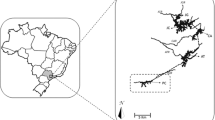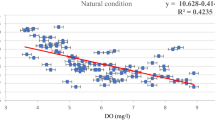Abstract
A laboratory culture of an Israeli benthic midge, Chironomus luridus, was exposed to two chemicals: copper and monochloramine. The objective of this study was to determine the protective nature of Chironomus' larval tube. Three experimental conditions were tested: larva with sand tubes, with silt tubes and without tubes. Larvae without tubes were significantly more sensitive to copper and chloramine than larvae that had sand or silt as tube building substrate. The tubes protected the insects against chemicals throughout 14 days of exposure time. Silt tubes had higher protective value than sand tubes, especially when exposed to copper for a short period of time (LC50/ 24 h, with silt, sand, or none: 80.0, 7.0 and 3.4 mg l−1 copper, respectively). C. luridus seemed to be better protected against copper than against chloramine (LC50/ 24 h, with silt, sand, or none: 12.2, 6.4 and 3.7 mg l−1 chloramine, respectively). The acute toxicity of copper to chironomid larvae was investigated using a cytochemical method. Larva in silt tubes had significantly higher non-specific esterase activity in midgut cells than larvae without tubes. We conclude that, in addition to its role in feeding, respiration and anti-predation shelter, the C. luridus tube protects its inhabitant from toxic substances.
Similar content being viewed by others
References
Alexander, M. K. R., W. Merrit & M. B. Berg, 1997. New strategies for the control of the partenogenetic chironomid (Paratanitarsus grimmii) (Diptera: Chironomidae) infesting water systems. J. am. Mosq. Control Assoc. 13: 189–192.
Ali, A. & J. K. Nayar, 1986. Efficacy of Bacillus sphericus Neide against larval mosquitoes (Diptera: Culicidae) and midges (Diptera: Chironomidae) in the laboratory. Florida Ent 69: 685–690.
[APHA] American Public Health Association, AWWA, WPCF. 1992. Standard Methods for the Examination of Water and Wastewater, 18th edn, APHA, Washington, DC.
Bay, E. C., A. A. Ingram & L. D. Anderson, 1966. Physical factors influencing chironomid infestation of water-spreading basins. Ann. Entomol. Soc. am. 59: 714–717.
Benke, A. C., 1998. Production dynamics of riverine chironomids: extremely high biomass turnover rates of primary consumers. Ecology 79: 899–910.
Black, W. C., 1986. Methods of Soil Analysis 1. American Society of Agronomy, Madison, WI.
Bresler, V. M., E. A. Belyaeva & M. G. Mozahaeva, 1990. A comparative study on the system of active transport of organic acids in Malpighian tubules of insects. J. Insect Physiol. 36: 256–270.
Broza, M., M. Halpern, B. Teltsch, R. Porat & A. Gasith, 1998. Shock chloramination: potential treatment for Chironomidae (Diptera) larvae nuisance abatement in water supply systems. J. Econ. Entomol. 91: 834–840.
Broza, M., M. Halpern & M. Inbar, 2000. Non-biting midges (Diptera; Chironomidae) in waste stabilization ponds: an intensifying nuisance in Israel. Wat. Sci. Tech. 42: 71–74
Burton, C. S. & J. H. Rodgers, 1994. Development of formulated reference sediments for freshwater and estuarine sediment testing. Envir. Toxicol. Chem. 13: 1163–1174.
Dimond, J. B., 1967. Evidence that drift of stream benthos is density related. Ecology 48: 855–857.
Edgar, W. D. & P. S. Meadows, 1969. Case construction, movement, spatial distribution and substrate selection in the larva of Chironomus riparius Meigen. J. exp. Biol. 50: 247–253.
Gauss, J. D., P. E. Woods, R. W. Winner & J. H. Skillings, 1985. Acute toxicity of copper to three life stages of Chironomus tentans as affected by water hardness alkalinity. Envir. Pollut. 37: 149–157.
Halpern, M., A. Gasith, R. Porat, B. Telsch & M. Broza, 1999. Synergistic effect of chloramine and copper sulfate as control agents of planktonic midge larvae (Diptera: Chironomidae) in drinking water supply systems. J. am. Mosq. Control Assoc. 15: 453–457.
Hatakeyama, S. & M. Yasuno, 1981. A method for assessing chronic effects of toxic substances on the midge Paratanytarsus partenogeneticus — Effect of copper. Arch. envir. Contam. Toxicol. 10: 705–713.
Hershey, A. E., 1987. Tubes and foraging behavior in larval Chironomidae: implication for predator avoidance. Oecologia 73: 236–241.
Ingersoll, C. G., G. T. Ankley, D. A. Benoit, E. L. Brunson, G. A. Burton, F. J. Dwyer, R. A. Hoke, P. F. Landrum, T. J. Norberg– King & P. V. Winger, 1995. Toxicity and bioaccumulation of sediment associated contaminants using freshwater invertebrates: a review of methods and applications. Envir. Toxicol. Chem. 14: 185–194.
Kondo, S., M. Ohba & T. Ishii, 1995. Comparative susceptibility of chironomid larvae (Dipt., Chironomidae) to Bacillus thuringiensis serovar israelensis with special reference to altered susceptibility due to food difference. Appl. Ent. 119: 123–125.
Koswalt, P. & A. Knight, 1987. Chronic toxicity of copper to partial life cycle of the midge, Chironomus decorus. Arch. envir. Contam. Toxicol. 16: 283–290.
Krantzberg, G. & P. M. Stokes, 1989. Metal regulation, tolerance, and body burdens in the larvae of the genus Chironomus. Can. J. Fish. aquat. Sci. 16: 389–398.
Macchiusi, F. & R. L. Baker, 1992. Effects of predators and food availability on activity and growth of Chironomus tentans (Chironomidae: Diptera) Freshwat. Biol. 28: 207–216.
Maier, K. J., P. Kosalwat & A. W. Knight, 1990. Culture of Chironomus decorus (Diptera: Chironomidae) and the effect of temperature on its life history. Envir. Ent. 19: 1681–1688.
Postma, J. F. & C. Davids, 1995. Tolerance induction and life cycle changes in cadmium-exposed Chironomus riparus (Diptera) during consecutive generations. Ecotox. Environ. Saf. 30: 195–202.
Postma, J. F., M. Kyed & W. Admiraal, 1995. Site specific differentiation in metal tolerance in the midge Chironomus riparius (Diptera, Chironomidae). Hydrobiologia 315: 159–165.
Rui-de-xue & A. Ali, 1997. Larval case-making behavior of a pestiferous chironomid, Glyptotendipes paripes (Diptera: Chironomidae), with sand grains of sizes. J. am. Mosq. Control Assoc. 13: 289–291.
Serentz, M. & A. A. Thaer, 1973. Microcapillary fluorometry and standardization for microscope fluorometry. In Thaer, A. A. & M. Serenze (eds), Fluorescense Techniques in Cell Biology. Springer-Verlag, Berlin.
Sokal, R. R. & F. J. Rohlf, 1998. Biometry, 4th edn. W. H. Freeman & Company, NY.
United States Environmental Protection Agency, 1988. US EPA toxicity data analysis software, for probit analysis of data from acute and short-term chronic toxicity tests with aquatic organisms. U.S. EPA. EMSL, EMRD, Cincinnati, OH.
Walshe, B. M., 1951. The feeding habits of certain Chironomid larvae (subfamily Tendipedinae). Proc. zool. Soc. London, 121: 63–79.
White, C. G., 1972. Handbook of Chlorination. Van Nostrand Reinhold, NY.
Winner, R. W., M. W. Bossel & M. P. Farrel, 1980. Insect community structure as an index of heavy-metal pollution in lotic ecosystems. Can. J. Fish. aquat. Sci. 37: 647–655.
Author information
Authors and Affiliations
Rights and permissions
About this article
Cite this article
Halpern, M., Gasith, A. & Broza, M. Does the tube of a benthic chironomid larva play a role in protecting its dweller against chemical toxicants?. Hydrobiologia 470, 49–55 (2002). https://doi.org/10.1023/A:1015665027535
Issue Date:
DOI: https://doi.org/10.1023/A:1015665027535




